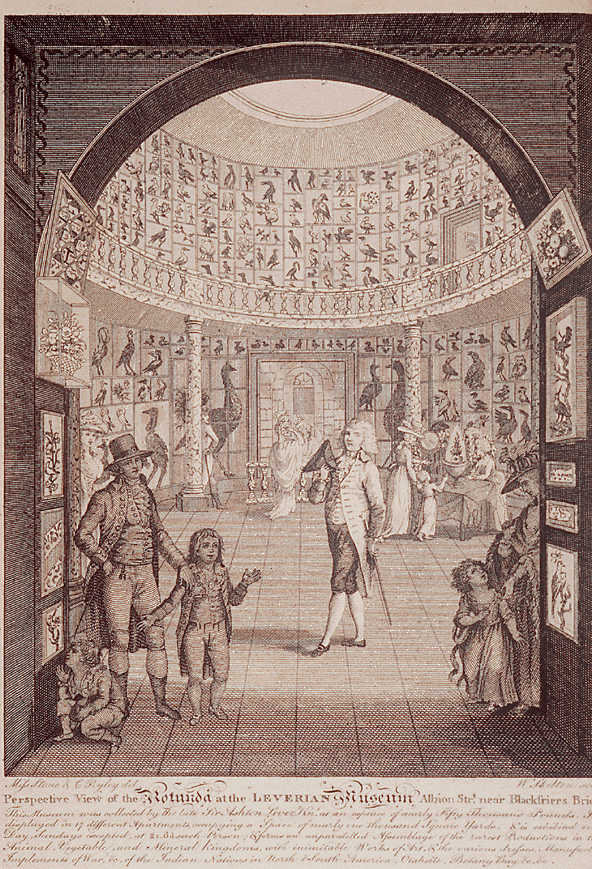April 27
Posted by sydney on Apr 27th, 2009

Mr. Lever’s museum, click for larger.
- 1793: April 27, 1793 – Men begin to pole their hops. Mountain snow-drop blows.
- 1792: April 27, 1792 – The middle Bantam hen sits in the barn. Planted four rows of potatoes in the home garden.
- 1789: April 27, 1789 – Showers, windy. One beech in the hanger shows some foliage.
- 1786: April 27, 1786 – Farmer Knight brought me 1/2 a ton of good meadow-hay.
- 1785: April 27, 1785 – Quick-set hedges look green. Roads are choaked with dust. Swallows frequent houses: some sit & dress themselves on trees, as if wet, & dirty.
- 1783: April 27, 1783 – Many swallows. Strong Aurora!!!
- 1782: April 27, 1782 – Hyacinths in full bloom. My sort is very fine.
- 1778: April 27, 1778 – INSERT: A day or two before any house-martins had been observed, Thomas Hoar distinctly heard pretty late one evening the twittering notes of those birds from under the eaves of my brewhouse, between the ceiling & the thatch. Now the quere is, whether those birds had harboured there the winter thro’, and were just awakening from their slumbers, or whether they had only just taken possession of that place unnoticed, & were lately arrived from some distant district. If the former was the case, they went not far to seek for a Hybernaculum, since they nestle every year along the eaves of that building. Mr Derham wrote word to the R. Society “that some time before any Swifts had been seen, (I think before the month of March was out), he head them squeaking behind the weather-tiles on the front of his parsonage-house.” It is a pity that so curious a Naturalist did not proceed to the taking-down some of the tiles, that he might have satisfyed his eyes as well as his hearing. As a notion had prevailed that Hirundines at first coming were lean & emaciated, I procured an H. martin to be shot as soon as it appeared: but the bird, when it come to be opened, was fat & fleshy. It’s stomach was full of the legs & wings of small coleoptera. There can be no doubt that the Horn shown to me at Mr Lever’s museum, vast as it was, belonged to the Genus of Bos: for it was concavum, antrorum verum lunatum laeve: whereas had it related to the Genus of Capra, it would have been concavum, sursum versum, erectum, scabrum. Neither can it by any means belong to the genus of Cervus, for then it would have been concavum, retorsum versum, intortum, rugosum. It must therefore of course have belonged to the Genus of Bos.
- 1777: April 27, 1777 – Notwithstanding the dry winter & spring, the pond on the common is brim full.
- 1775: April 27, 1775 – Early tulips blow. A pair of house-martins appear, & frequent the nest at the end of the house; a single one also wants to go in. THese must be of the family bred there last year. The nest was built last summer. The martins throw the rubbish out of their nest. Bank-martins abound on short-heath: they come full as soon as the house-swallow. Two swans inhabit Oakhanger-ponds: they came of themselves in the winter with three more. Pulled won many old House-martin’s nests; they were full of rubbish, & the exuviae of the Hippobosca hirundinis in the pupa state. These insects obtain so much sometimes in yir nests, as to render the place insupportable to the young, & to oblige them to throw themselves to the ground. The case is the same sometimes with young swifts.
- 1774: April 27, 1774 – Oaks are felled: the bark runs freely. Many swallows. Two swifts round the church.
- 1772: April 27, 1772 – Ground dries, & binds up very hard.
- 1769: April 27, 1769 – Dutch plaice abound. Turbots.
Mr Lever’s museum, the Holophusikon, was a huge collection of interesting stuff connected with natural history in Leicester House– one of the largest and latest Cabinets of Curiosities, housing much of the specimens brought back by Captain Cook from around the globe. The ox horn White is discussing though seems to have been an ancient British one.
 Theme Ported to
Theme Ported to